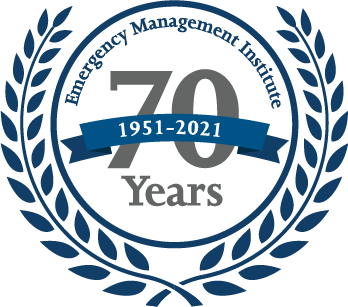
Leadership in a Time of Great Change

Stephen Sharro
I had the privilege of helping to lead EMI from 1990 to 2006. I served as Deputy Superintendent from 1990 to 2000, and as Superintendent from 2000 to 2006. These were, of course, tumultuous years for the Nation and years of great change for the business of emergency management.
When I joined EMI in 1990, FEMA was struggling to address perceived shortfalls in the response to Hurricane Hugo and the Loma Prieta earthquake. EMI became a central focus of these efforts because of the perceived need to improve the skills of emergency management personnel, both inside FEMA and among our state, local, tribal, and territorial (SLTT) partners. Because of this, the early 1990s were transformative for EMI.
Until that time, EMI had been a pastoral venue that emergency management personnel from across the Nation enjoyed visiting from time to time to network and take courses that were informative but not particularly demanding. At that time, there were no tests in EMI courses; failing a state or local emergency manager was unthinkable. The only evaluative tools EMI had to rely on were the opinion surveys that participants completed at the end of their courses. These surveys were invariably glowing except for the occasional complaint about the food in the dining hall or the lack of televisions in the student dormitory rooms.
Our clear goal during these years was to elevate emergency management to a recognized profession and improve the competence of emergency management workers across the Nation. Recognizing EMI’s potential role in this process, the EMI Superintendent at the time, Laura Buchbinder, believed that EMI could do more and be more. Laura quickly refocused EMI on providing true performance-based training. She made new hires—including me—and provided training for EMI staff. Over the next few years, we added rigor to EMI’s courses and refocused the curriculum on helping emergency management personnel develop the hard skills they needed to do their important jobs.
Hurricane Hugo highlighted the role of elected and appointed officials in disasters and emergencies. The bigger the incident, the more important parts they play. So, we expanded EMI’s audience to include mayors, city managers, department heads, coroners/medical examiners, etc.
EMI’s scenario and community-specific, team-based Integrated Emergency Management Course (IEMC), under the leadership of Al Fluman, quickly became the centerpiece of EMI training. Focusing on interoperability and unity of effort among the various community organizations—fire, police, public works, emergency medical services, emergency management, mayor, city council, and public affairs—the demand for IEMCs skyrocketed.
The morning the Murrah Federal Building in Oklahoma City was bombed in April 1995, the Oklahoma City Assistant Fire Chief asked us to send the instructors from their recent IEMC to assist and mentor city leaders during the response. Our team was in Oklahoma the following day.
Jack Welch, the former Chief Executive Officer of General Electric and a corporate leadership guru, said something to the effect that “any training unit that does not contribute directly and measurably to the success of the mission of its organization should not exist.” Recognizing EMI’s responsibilities as FEMA’s in-house training organization, in January 1994, we deployed EMI’s first on-site disaster training team. I led a group of EMI instructors to Los Angeles, in the wake of the Northridge Earthquake, where we used EMI courses and other training materials cobbled together on the spot to provide just-in-time training for FEMA personnel, California State employees, and local hires at the Disaster Field Office (then called the “Joint Field Office”). This EMI expeditionary training capability would soon be institutionalized as the Disaster Field Training Organization (DFTO). It continues today as a key support element for FEMA’s disaster workforce.
John McKay succeeded Laura Buchbinder as EMI Superintendent in 1993 and brought his keen political insight to EMI. Over the next few years, EMI’s role expanded to include educating and training FEMA personnel and serving as a clearinghouse for FEMA doctrine and policy.
At this time, in keeping with our goal of professionalizing emergency management, EMI instituted the FEMA Higher Education Program. Under the leadership of FEMA Associate Administrator Kay Goss and through the tireless efforts of Dr. Wayne Blanchard, EMI encouraged colleges and universities across the country to develop and offer post-secondary degree programs in emergency management and related fields.
By 2006 when I left EMI, every state and several U.S. territories had at least one institution of higher learning offering emergency management degrees.
When I became Superintendent of EMI in 2000, the FEMA Administrator, James Lee Witt, combined all FEMA training activities, except for the National Fire Academy, into a new Training Division with EMI as the leading organization. This firmly consolidated EMI’s traditional role of training for SLTT partners with the responsibility to train FEMA’s disaster workforce. Also included in the Training Division was the Agency’s employee development function. This reorganization provided great economy of scale and enabled the training efforts in one part of the Agency to benefit from activities and expertise that were being developed and applied in other parts of the organization.
Another significant change for EMI in the early 2000s was the explosion of EMI’s Independent Study program as we began offering interactive, online courses. With little in the way of new funding and limited experience in developing nation-wide programs of online instruction, Dennis Hickethier led these efforts. The results surprised us all. During the first years that online courses were available from EMI, annual enrollments jumped from several thousand to more than one million, and at a cost of less than 50 cents per enrollment.
Like the rest of the Nation, EMI was profoundly affected by the events of September 11, 2001. The curriculum changed to adjust to new threats and hazards, and a general urgency affected everything we did. A series of reorganizations within FEMA followed the establishment of the Department of Homeland Security. Among the important things that happened during these years was that EMI inherited the Noble Hospital training center in Anniston, Alabama. Suddenly, under the leadership of Deputy Superintendent Richard Callis, EMI became a center of excellence for the development and delivery of hands-on mass-casualty incident training. This included an innovative new IEMC exclusively focused on hospitals.
During the years following the establishment of DHS, EMI also became the trainer for the DHS leadership’s national initiatives such as the National Response Plan (NRP, which would become the National Response Framework a few years later) and the National Incident Management System (NIMS). Working closely with the DHS Implementation Team (I-Team), EMI’s Bonnie Butler and other staff members developed Independent Study courses on the NRP (IS-800) and NIMS (IS-700) and made those courses available online the day Secretary Tom Ridge announced the guidance.
I left my work at EMI in 2006 and retired from Federal Service. (Hurricane Katrina in 2005 had been more fun than I could stand.) Cortez Lawrence became the next Superintendent of EMI.
The great faculty and staff at EMI, along with a dedicated group of contracted subject-matter experts, accomplished many other incredible things, e.g., offering the first EMI courses for tribal governments, the first EMI course on dealing with animals in disasters, and the first course on mass fatalities incidents. We also arranged for college credits for EMI courses through the American Council on Education, partnered with the International Association of Emergency Managers (IAEM) to create the Certified Emergency Manager Program, developed the EMI Master Trainer and the Master Exercise Practitioner Programs, and brought Community Emergency Response Teams to national prominence.
The staff of EMI accomplished these things working in Emmitsburg, in the 10 FEMA Regional offices, at FEMA Headquarters, in Anniston, at FEMA disaster sites, and across the country through EMI’s field delivery and Independent Study courses. And they did it on a shoestring budget and with little in the way of headlines or adulation. Those who were with EMI, who led EMI, and who supported EMI during the years at the turn of the 21st century surely did their part in EMI’s 70 years of excellence and service to the Nation.
